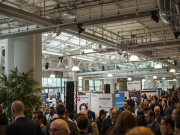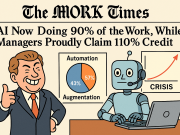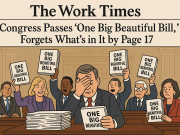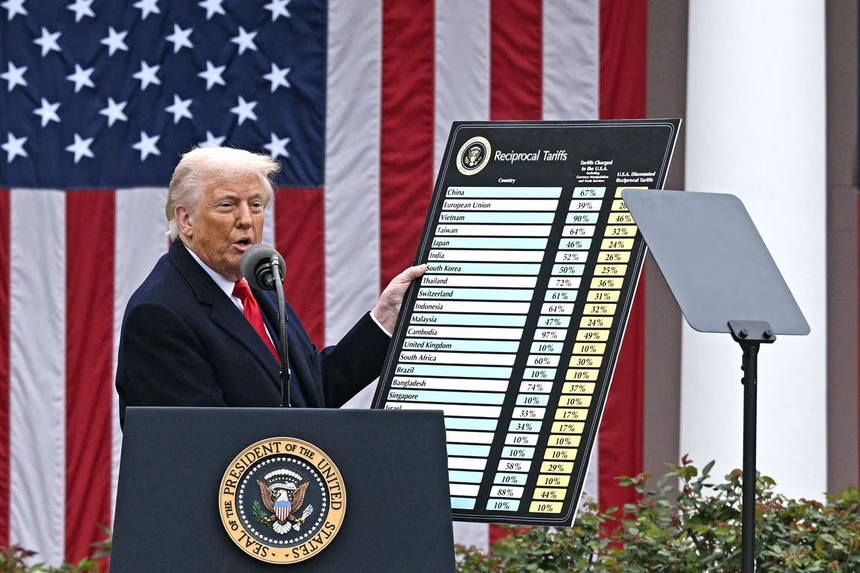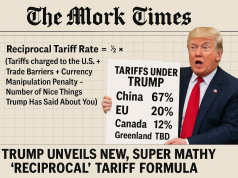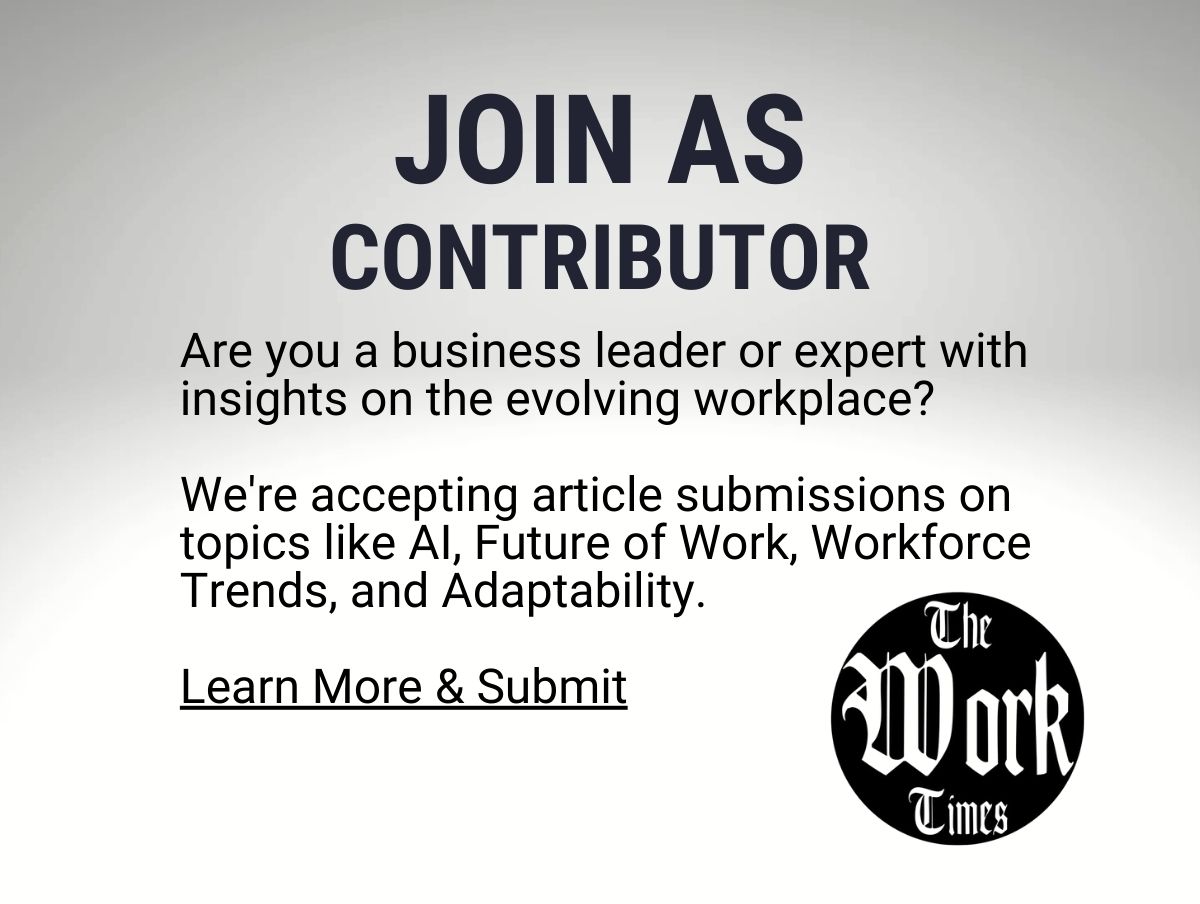Much like the ancient Greek tale of Sisyphus—forever condemned to roll a boulder uphill only to watch it tumble back down—our trade policy appears to be pushing a similar stone up the slope of economic balance. The United States Trade Representative (USTR), in a well-intentioned effort to correct persistent trade imbalances, has rolled out a formula for “reciprocal tariffs.” The goal? Zero out bilateral trade deficits through mathematical precision.
But as every gardener knows, watering a wilting plant doesn’t fix poor soil. You need to look deeper.
The Formula of Reciprocity: A Noble Attempt at Symmetry
The USTR’s approach is elegantly simplistic: If country A exports more to us than we export to them, slap on a tariff that nudges the imbalance toward zero. They call this the “reciprocal tariff”—calculated using the following equation:
Δτ_i × ε × φ × m_i = x_i – m_i
Where:
- Δτ_i is the tariff adjustment for country i,
- ε is the price elasticity of import demand (how sensitive buyers are to price changes),
- φ is the tariff pass-through to consumer prices (how much of the tariff gets felt at the store),
- m_i is our imports from them,
- x_i is our exports to them.
In short, it’s a model that tries to reverse-engineer tariffs to close trade deficits using economic assumptions.
The average result? Tariff suggestions ranging from 0% to a stunning 99%, with a mean around 41%. In policy-speak, this is the equivalent of saying, “We’re not mad, we’re just really disappointed.”
The Trouble with Tidy Equations
But like trying to calculate love using chemistry or predicting community resilience with GDP alone, the reciprocal tariff formula falls prey to a fundamental flaw: it reduces complexity into a narrow view of fairness.
Let’s unpack what’s missing:
- Non-Tariff Realities: The USTR admits that things like environmental regulations, currency manipulation, and tax policy also distort trade—but the formula proxies all of these by simply hiking tariffs. This is like treating a fever by turning down the thermostat instead of curing the infection.
- Elasticity Assumptions: The model assumes that Americans will dramatically shift their buying habits when tariffs go up. Reality? We’re still buying coffee from Colombia and electronics from China despite previous tariffs. Elasticity isn’t just a number; it’s also about brand loyalty, convenience, and what’s not easily replaceable.
- No Feedback Loops: This is a static model pretending to operate in a dynamic world. What happens when the other country retaliates? What if our exporters lose access or competitive edge? What if global supply chains reroute around us?
Even the economists cited (Broda, Weinstein, Boehm, et al.) show wide variations in elasticity estimates, signaling just how imprecise this compass really is.
Use Our Coefficient Friends, How to Fix This, Minimastically
Yes, that’s a made-up word—but it works. “Minimastically”: minimal interventions that produce maximal system-wide improvements.
Here’s how:
- Index for Systemic Fairness, Not Just Symmetry: Rather than blindly aiming for trade deficit zero, we should assess fairness in access, standards, and opportunity. This calls for a Human-Centric Trade Index—evaluating how policies impact jobs, local supply chains, and ecological resilience. Much like TAO.ai’s HumanPotentialIndex, it moves the focus from what’s easy to count to what truly counts.
- Ecosystem Thinking: Borrow a page from nature. A thriving forest doesn’t force each tree to exchange equal amounts of sunlight or water; it builds networks of mutual support through diversity. Trade policy must encourage collaboration—joint ventures, tech transfer, capacity building—not just protectionism.
- Community-Centered Metrics: A surplus on the ledger means little if it comes at the cost of community decline. Instead of measuring success in export dollars, why not count factories reopened, apprenticeships started, or small businesses scaled?
- Stress-Test the Model: Before deploying tariff hikes like economic warfare, simulate ripple effects across industries, regions, and demographics. Use digital twins of the economy, not just PDFs of formulas.
To fix the reciprocal tariff formula minimastically—i.e., with the least disruption but maximum enhancement of fairness—we can tweak its structure to incorporate adaptive, human-centered feedback and multi-dimensional fairness. Here’s how this can be achieved in three surgical steps:
🔧 1. Add a Fairness Multiplier (ψ): Adjust for Non-Tariff Discrimination
Current flaw: The original formula assumes that the only lever to fix a trade imbalance is a tariff adjustment. But non-tariff barriers (NTBs)—like excessive regulations, discriminatory certifications, or opaque customs procedures—play a massive hidden role.
Fix: Introduce a Fairness Multiplier (ψ) to reflect the cumulative effect of NTBs, calculated via proxy indices (like World Bank’s Doing Business Index, OECD’s trade restrictiveness indicators, etc.)
Modified formula:
Δτi × ε × φ × mi × ψ = xi−mi
Where:
- ψ > 1 if NTBs are high (i.e., foreign countries make it hard for U.S. exports),
- ψ = 1 if the trade environment is relatively neutral.
This ensures that tariffs aren’t over-applied to countries that are actually fair, or under-applied where real barriers exist beyond pricing.
🧠 2. Make Elasticity Dynamic (εᵢ): Recognize Sectoral Sensitivity
Current flaw: The formula uses a static elasticity of 4 across all countries and industries. But the elasticity of toys isn’t the same as that of turbines.
Fix: Use dynamic or sector-specific elasticity values (εᵢ) based on industry data. This creates a more precise, minimally disruptive tariff regime.
For example:
- εᵢ = 1.2 for pharmaceuticals (inelastic),
- εᵢ = 6.5 for fast fashion (elastic).
This avoids punishing U.S. consumers unnecessarily in low-elasticity sectors, and instead targets where tariffs can actually change behavior.
🌱 3. Apply a Resilience Adjustment Factor (ρ): Empower Local Ecosystems
Current flaw: The formula sees tariffs purely as economic equalizers, not as tools to strengthen domestic communities.
Fix: Introduce a Resilience Adjustment Factor (ρ) to support strategic reshoring, job creation, and Worker1-led ecosystems. ρ would prioritize tariffs where domestic capacity exists (or can be grown) to absorb import reductions without major disruptions.
ρ > 1 = strategic sector with high domestic potential (e.g., EV batteries, microchips).
ρ < 1 = sector where domestic capacity is weak and consumers would be harmed (e.g., rare earths).
🧮 The Refined Formula (Minimastically Enhanced):
Δτi × εi × φ × mi × ψ × ρ = xi−mi
This version:
- Recognizes real barriers to fair trade (ψ),
- Accounts for demand sensitivity across sectors (εᵢ),
- Empowers resilient reshoring and local job creation (ρ),
- While still achieving the ultimate goal: reciprocal and fair trade.
🎯 Why This Works Minimastically
These enhancements:
- Don’t require overhauling global trade rules,
- Use available data from existing global indices and industry reports,
- Allow for nuanced, surgical tariff applications that target fairness without economic whiplash.
The outcome? A more intelligent, just, and community-strengthening approach to tariffs—one that doesn’t just balance trade but builds resilient ecosystems where human potential thrives.
Conclusion: Building Forward, Not Just Back
The reciprocal tariff formula is an earnest attempt to correct long-standing imbalances, but as with many things built in the name of fairness, it risks enforcing symmetry over equity.
We don’t need a bigger hammer; we need a better blueprint.
Let’s move beyond punitive models and invest in adaptive trade ecosystems—where the goal isn’t just to break even, but to build communities where Worker1—the resilient, compassionate, and high-performing professional—can thrive.
Because at the end of the day, it’s not about the trade deficit. It’s about the human potential surplus we’re leaving untapped.

